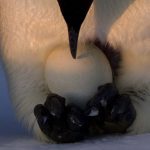
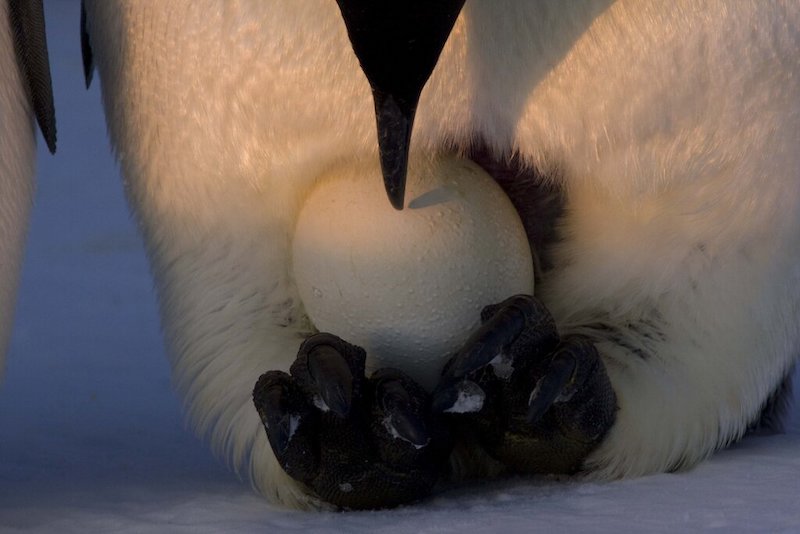
Emperor penguin dad keeps his egg warm while waiting for his chick to hatch. Image via Tony Bojkovski/ Australian Antarctic Division.
We know there are some awesome dads out there among you humans. But the nominees for best dad must surely include emperor penguin males, who go to extraordinary extremes for their offspring, enduring bitter cold and darkness during winter on Earth’s coldest continent, Antarctica. It’s winter in Antarctica now. If you could visit, you’d find emperor penguin males gathered in colonies near the coast. They’re tightly huddled together to stay warm in temperatures that can dip as low as -40 degrees F (-40 degrees C), with winds as strong as 90 miles per hour (144 km/ hour). For the next two months, these devoted dads will each incubate a single egg that holds his offspring. Each dad will also care for his chick when it first hatches. Penguin dads do all this while surviving only on fat reserves from the previous summer.
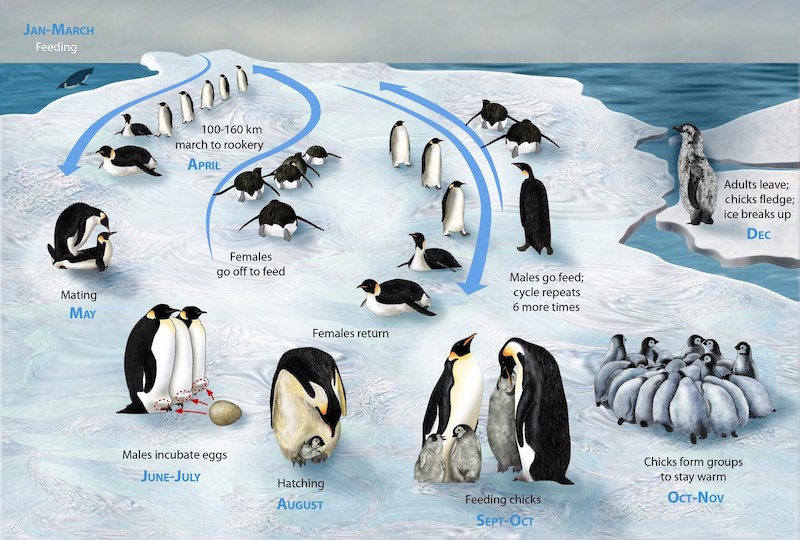
A diagram of the emperor penguin’s breeding schedule. Image via Zina Deretsky/ NSF/ Wikimedia Commons.
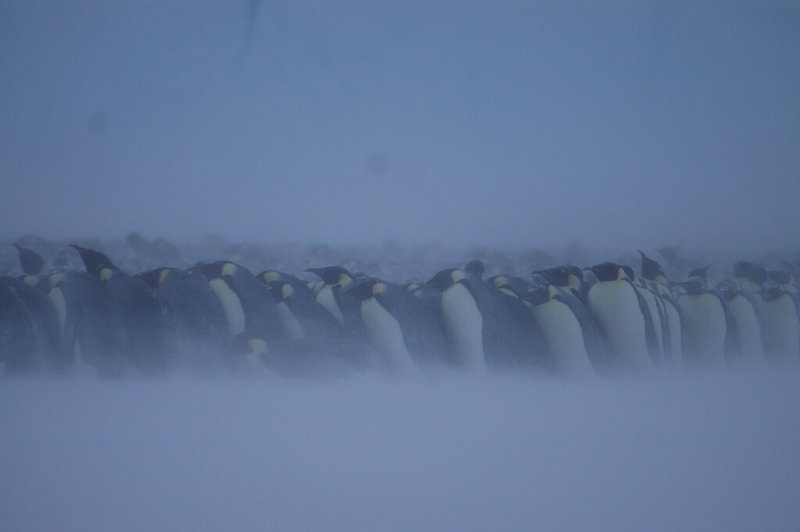
Emperor penguins huddle during a blizzard. Image via Frederique Olivier/ Australian Antarctic Division.
For much of the summer, male and female emperor penguins are at sea, feeding on fish, squid, and krill. For the males, it’s an opportunity to accumulate fat reserves they’ll need to survive in winter.
In April, autumn in the Southern Hemisphere, adult emperor penguins begin congregating at their respective nesting areas, traveling inland as much as 30 to 75 miles (50 to 120 kilometers) from the pack ice.
Following courtship displays, the birds form pairs and mate. In May and early June, the female lays a single egg. The egg is pear-shaped with a pale greenish-white tint, almost 5 inches long and 3 inches wide (12 and 8 cm, respectively). The female penguin passes the egg to her mate, then heads back to sea. She’ll be back in two months to continue her parental duties.
Until then, the males are on their own for winter in Antarctica. Their dense insulating feathers and fat accumulations, however, aren’t enough to keep them alive. To conserve heat, the emperor penguin males huddle close together. Each colony varies in size, and could number several hundred birds. They take turns moving from the edge of the colony, which is colder, to the warmer center.
The egg, meanwhile, is snugly tucked away in dad’s brood pouch, resting on his feet. If all goes well, the chick will hatch in 65 to 75 days. Hatching will likely happen a few days before mom returns. During this time, the chick, weighing just 11 ounces (312 grams) with only a thin layer of down feathers, is completely dependent on dad for warmth and protection. Until mom returns to start feeding the chick, he also provides his offspring with what’s called crop milk, a high fat and protein secretion.
Mom returns to the colony, sometime between mid-July and early August, after spending the last two months feeding at sea. She takes over caring for the chick while dad, having not eaten for about 120 days, heads to the ocean to start feeding. By now, he has dropped in weight to around 50 pounds (23 kilograms) from his summer weight of about 84 pounds (38 kilograms).
Dad will spend about three to four weeks feeding at sea, then return to his mate. From then on, the pair takes turns caring for their little one, keeping it warm and feeding it regurgitated krill, fish, and squid.

An emperor penguin pair with their chick. Image via Gary Miller / Australian Antarctic Division.
About 50 days after hatching, the colony’s chicks, now sporting a thick downy coat, are corralled together for warmth and protection in what’s called a crèche – that’s emperor penguin daycare where the chicks wait for their parents to return from the sea to feed them.
In early November, as spring yields to summer in Antarctica, the chicks undergo a two-month moult, replacing their downy chick feathers with juvenile plumage that will enable them to swim.
By December and January, the chicks are nearly as big as their parents. At this point, mom and dad have done their job and will stop feeding the kids. The youngsters will then venture to sea to start foraging on their own. In about three to four years, they will be old enough to start breeding.
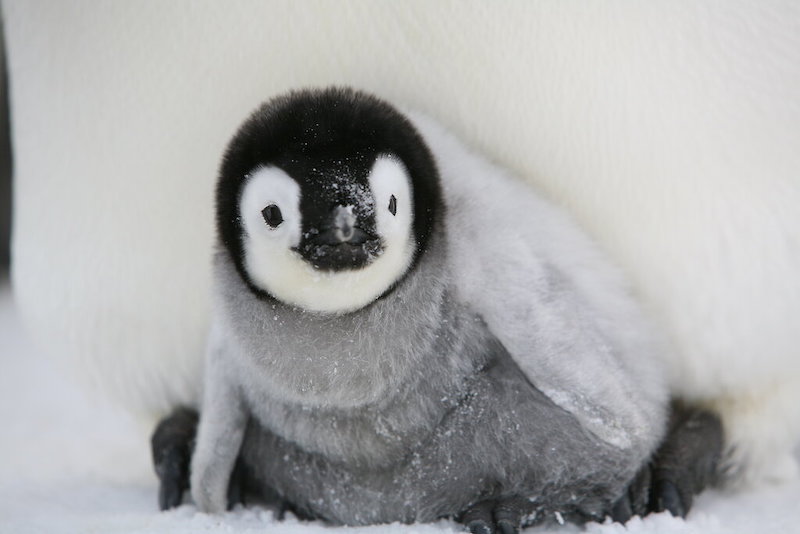
An emperor penguin chick. Image via Robin Mundy/ Australian Antarctic Division.
Bottom line: Male emperor penguins are some of the best dads in the world. They incubate their eggs for over two months in the frigid Antarctic winter.
from EarthSky https://ift.tt/3ep5Zto


Emperor penguin dad keeps his egg warm while waiting for his chick to hatch. Image via Tony Bojkovski/ Australian Antarctic Division.
We know there are some awesome dads out there among you humans. But the nominees for best dad must surely include emperor penguin males, who go to extraordinary extremes for their offspring, enduring bitter cold and darkness during winter on Earth’s coldest continent, Antarctica. It’s winter in Antarctica now. If you could visit, you’d find emperor penguin males gathered in colonies near the coast. They’re tightly huddled together to stay warm in temperatures that can dip as low as -40 degrees F (-40 degrees C), with winds as strong as 90 miles per hour (144 km/ hour). For the next two months, these devoted dads will each incubate a single egg that holds his offspring. Each dad will also care for his chick when it first hatches. Penguin dads do all this while surviving only on fat reserves from the previous summer.

A diagram of the emperor penguin’s breeding schedule. Image via Zina Deretsky/ NSF/ Wikimedia Commons.

Emperor penguins huddle during a blizzard. Image via Frederique Olivier/ Australian Antarctic Division.
For much of the summer, male and female emperor penguins are at sea, feeding on fish, squid, and krill. For the males, it’s an opportunity to accumulate fat reserves they’ll need to survive in winter.
In April, autumn in the Southern Hemisphere, adult emperor penguins begin congregating at their respective nesting areas, traveling inland as much as 30 to 75 miles (50 to 120 kilometers) from the pack ice.
Following courtship displays, the birds form pairs and mate. In May and early June, the female lays a single egg. The egg is pear-shaped with a pale greenish-white tint, almost 5 inches long and 3 inches wide (12 and 8 cm, respectively). The female penguin passes the egg to her mate, then heads back to sea. She’ll be back in two months to continue her parental duties.
Until then, the males are on their own for winter in Antarctica. Their dense insulating feathers and fat accumulations, however, aren’t enough to keep them alive. To conserve heat, the emperor penguin males huddle close together. Each colony varies in size, and could number several hundred birds. They take turns moving from the edge of the colony, which is colder, to the warmer center.
The egg, meanwhile, is snugly tucked away in dad’s brood pouch, resting on his feet. If all goes well, the chick will hatch in 65 to 75 days. Hatching will likely happen a few days before mom returns. During this time, the chick, weighing just 11 ounces (312 grams) with only a thin layer of down feathers, is completely dependent on dad for warmth and protection. Until mom returns to start feeding the chick, he also provides his offspring with what’s called crop milk, a high fat and protein secretion.
Mom returns to the colony, sometime between mid-July and early August, after spending the last two months feeding at sea. She takes over caring for the chick while dad, having not eaten for about 120 days, heads to the ocean to start feeding. By now, he has dropped in weight to around 50 pounds (23 kilograms) from his summer weight of about 84 pounds (38 kilograms).
Dad will spend about three to four weeks feeding at sea, then return to his mate. From then on, the pair takes turns caring for their little one, keeping it warm and feeding it regurgitated krill, fish, and squid.

An emperor penguin pair with their chick. Image via Gary Miller / Australian Antarctic Division.
About 50 days after hatching, the colony’s chicks, now sporting a thick downy coat, are corralled together for warmth and protection in what’s called a crèche – that’s emperor penguin daycare where the chicks wait for their parents to return from the sea to feed them.
In early November, as spring yields to summer in Antarctica, the chicks undergo a two-month moult, replacing their downy chick feathers with juvenile plumage that will enable them to swim.
By December and January, the chicks are nearly as big as their parents. At this point, mom and dad have done their job and will stop feeding the kids. The youngsters will then venture to sea to start foraging on their own. In about three to four years, they will be old enough to start breeding.

An emperor penguin chick. Image via Robin Mundy/ Australian Antarctic Division.
Bottom line: Male emperor penguins are some of the best dads in the world. They incubate their eggs for over two months in the frigid Antarctic winter.
from EarthSky https://ift.tt/3ep5Zto

Aucun commentaire:
Enregistrer un commentaire